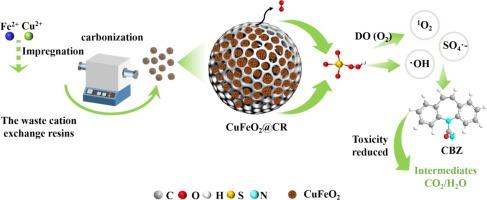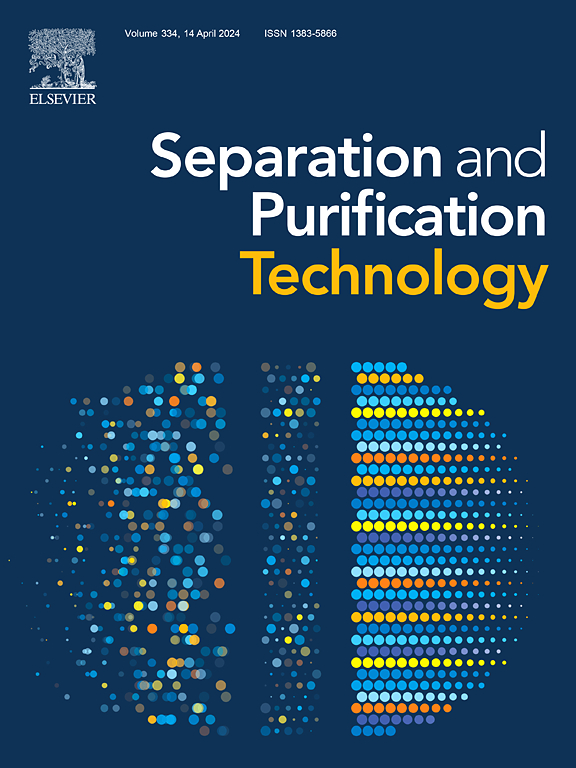The efficient degradation of carbamazepine by Cu-Fe bimetallic composite carbon derived from the waste cation exchange resins: Mechanism, ecotoxicity, and continuous flow catalysis
IF 8.1
1区 工程技术
Q1 ENGINEERING, CHEMICAL
引用次数: 0
Abstract
The Cu-Fe bimetallic composite carbon (CuFeO2@CR) was synthesized by using the waste cation exchange resins as the carbon source to degrade carbamazepine (CBZ) by activating peroxymonulfate (PMS). Results found that 91.3 % of CBZ was degraded under the optimal condition ([PMS] = 0.2 g/L, [CuFeO2@CR] = 0.3 g/L, T = 25℃). CuFeO2@CR could efficiently degrade CBZ at pH 3.03–9.02 and maintain the degradation at 83.6 % in the fifth cycle. The reactive oxygen species (ROS) were SO4•−, •OH, and 1O2 with the relative contribution of 35 %, 29 %, and 36 %, respectively. DFT calculation demonstrated that CuFeO2@CR exhibited a preferential affinity for PMS and greater transfer electrons capacity than CR. Three reaction pathways were proposed in the CuFeO2@CR/PMS system, and the degradation could effectively reduce the toxicity into non-toxic. The continuous flow catalytic experiment indicated the promising application in the treatment of antibiotic wastewater. This work provides guidance and theoretical support for CBZ degradation mechanisms.

从废弃阳离子交换树脂中提取的 Cu-Fe 双金属复合碳高效降解卡马西平:机理、生态毒性和连续流催化作用
以废弃阳离子交换树脂为碳源合成了铜铁双金属复合碳(CuFeO2@CR),通过活化过一硫酸盐(PMS)降解卡马西平(CBZ)。结果发现,在最佳条件下([PMS] = 0.2 g/L,[CuFeO2@CR] = 0.3 g/L,T = 25℃),CBZ 的降解率为 91.3%。在 pH 值为 3.03-9.02 的条件下,CuFeO2@CR 可高效降解 CBZ,且在第五个循环中降解率保持在 83.6%。活性氧(ROS)为SO4--、-OH和1O2,相对贡献率分别为35%、29%和36%。DFT 计算表明,与 CR 相比,CuFeO2@CR 对 PMS 具有更高的亲和力和更强的电子转移能力。在 CuFeO2@CR/PMS 体系中提出了三种反应途径,降解过程可有效地将毒性降低为无毒。连续流催化实验表明,该技术在抗生素废水处理中具有广阔的应用前景。这项工作为 CBZ 降解机理提供了指导和理论支持。
本文章由计算机程序翻译,如有差异,请以英文原文为准。
求助全文
约1分钟内获得全文
求助全文
来源期刊

Separation and Purification Technology
工程技术-工程:化工
CiteScore
14.00
自引率
12.80%
发文量
2347
审稿时长
43 days
期刊介绍:
Separation and Purification Technology is a premier journal committed to sharing innovative methods for separation and purification in chemical and environmental engineering, encompassing both homogeneous solutions and heterogeneous mixtures. Our scope includes the separation and/or purification of liquids, vapors, and gases, as well as carbon capture and separation techniques. However, it's important to note that methods solely intended for analytical purposes are not within the scope of the journal. Additionally, disciplines such as soil science, polymer science, and metallurgy fall outside the purview of Separation and Purification Technology. Join us in advancing the field of separation and purification methods for sustainable solutions in chemical and environmental engineering.
 求助内容:
求助内容: 应助结果提醒方式:
应助结果提醒方式:


